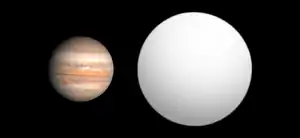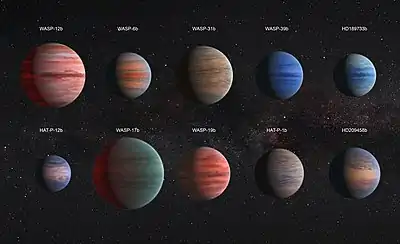WASP-17b
WASP-17b is an exoplanet in the constellation Scorpius that is orbiting the star WASP-17. Its discovery was announced on 11 August 2009.[1] It is the first planet discovered to have a retrograde orbit, meaning it orbits in a direction counter to the rotation of its host star.[1] This discovery challenged traditional planetary formation theory.[4] In terms of diameter, WASP-17b is one of the largest exoplanets discovered and at half Jupiter's mass, this made it the most puffy planet known in 2010.[5] On 3 December 2013, scientists working with the Hubble Space Telescope reported detecting water in the atmosphere of the exoplanet.[6][7]
 Size comparison of WASP-17b (right) with Jupiter (left). | |
| Discovery | |
|---|---|
| Discovered by | David R. Anderson et al.[1] |
| Discovery date | 11 August 2009 |
| Transit (including secondary eclipse) | |
| Orbital characteristics | |
| 0.0515 (± 0.00034) AU | |
| Eccentricity | 0.028 +0.018 −0.015 |
| 3.735438 (± 6.8e-06) d | |
| Inclination | 86.83 +0.56 −0.68[2] |
| −70 | |
| Star | WASP-17 |
| Physical characteristics | |
Mean radius | 1.991 (± 0.081)[note 1][2][1] RJ |
| Mass | 0.486 (± 0.032) MJ |
| Temperature | 1550 +170 −200 [3] K |
| |
WASP-17b is named Ditsö̀. The name was selected in the NameExoWorlds campaign by Costa Rica, during the 100th anniversary of the IAU. Ditsö̀ is the name that the god Sibö̀ gave to the first Bribri people in Talamancan mythology.[8][9]
Discovery
A team of researchers led by David Anderson of Keele University in Staffordshire, England, discovered the gas giant, which is about 1,000 light years (300 parsecs) from Earth, by observing it in transit its host star WASP-17. Such photometric observations also reveal the planet's size. The discovery was made with a telescope array at the South African Astronomical Observatory. Due to the involvement of the Wide Angle Search for Planets SuperWASP consortium of universities, the exoplanet, as the 17th found to date by this group, was given its present name.[10]
Astronomers at the Observatory of Geneva were then able to use characteristic red shifts and blue shifts in the host star's spectrum as its radial velocity varied over the course of the planet's orbit to measure the planet's mass and obtain an indication of its orbital eccentricity.[1] Careful examination of the Doppler shifts during transits also allowed them to determine the direction of the planet's orbital motion relative to its parent star's rotation via the Rossiter–McLaughlin effect.[1]
Orbit
WASP-17b is thought to have a retrograde orbit (with a sky-projected inclination of the orbit normal against the stellar spin axis of about 149°,[11] not to be confused with the line-of-sight inclination of the orbit, given in the table, which is near 90° for all transiting planets), which would make it the first planet discovered to have such an orbital motion. It was found by measuring the Rossiter–McLaughlin effect of the planet on the star's Doppler signal as it transited, in which whichever of the star's hemispheres is turning toward or away from Earth will show a slight blueshift or redshift which is dampened by the transiting planet. Scientists are not yet sure why the planet orbits opposite to the star's rotation. Theories include a gravitational slingshot resulting from a near-collision with another planet, or the intervention of a smaller planet-like body working to gradually change WASP-17b's orbit by tilting it via the Kozai mechanism.[12]
Spin-orbit angle measurement was updated in 2012 to -148.7+7.7
−6.7°.[13]
Physical properties
WASP-17b has a radius between 1.5 and 2 times that of Jupiter and about half the mass.[1] Thus its mean density is between 0.08 and 0.19 g/cm3,[1] compared with Jupiter's 1.326 g/cm3[14] and Earth's 5.515 g/cm3 (the density of water is 1 g/cm3). The unusually low density is thought to be a consequence of a combination of the planet's orbital eccentricity and its proximity to its parent star (less than one seventh of the distance between Mercury and the Sun), leading to tidal flexing and heating of its interior.[1] The same mechanism is behind the intense volcanic activity of Jupiter's moon Io. WASP-39b has a similarly low estimated density.
Exoplanetary sodium in the atmosphere of the WASP-17 has been detected.[3]

From top left to lower right: WASP-12b, WASP-6b, WASP-31b, WASP-39b, HD 189733b, HAT-P-12b, WASP-17b, WASP-19b, HAT-P-1b and HD 209458b.
See also
- HAT-P-7b, another exoplanet announced to have a retrograde orbit the day after the WASP-17b announcement
- TrES-4, another large exoplanet with a low density
- List of exoplanet extremes
Notes
References
- Anderson, D. R.; et al. (2010). "WASP-17b: An Ultra-Low Density Planet in a Probable Retrograde Orbit". The Astrophysical Journal. 709 (1): 159–167. arXiv:0908.1553. Bibcode:2010ApJ...709..159A. doi:10.1088/0004-637X/709/1/159.
- "Planet: WASP-17 b". The Extrasolar Planet Encyclopedia. Retrieved 14 August 2009.
- Khalafinejad, Sara (2018). "The atmosphere of WASP-17b: Optical high-resolution transmission spectroscopy". Astronomy and Astrophysics. 618: 13. arXiv:0908.1553. doi:10.1088/0004-637X/709/1/159.
- "A planet going the wrong way", Phys Org. June 7, 2011. Accessed June 10, 2011
- Rachel Kaufman (17 August 2009). ""Backward" Planet Has Density of Foam Coffee Cups". National Geographic. National Geographic Society. Retrieved 6 February 2011.
- Staff (3 December 2013). "Hubble Traces Subtle Signals of Water on Hazy Worlds". NASA. Retrieved 4 December 2013.CS1 maint: uses authors parameter (link)
- Mandell, Avi M.; Haynes, Korey; Sinukoff, Evan; Madhusudhan, Nikku; Burrows, Adam; Deming, Drake (3 December 2013). "Exoplanet Transit Spectroscopy Using WFC3: WASP-12 b, WASP-17 b, and WASP-19 b". Astrophysical Journal. 779 (2): 128. arXiv:1310.2949. Bibcode:2013ApJ...779..128M. doi:10.1088/0004-637X/779/2/128.
- "Approved names". NameExoworlds. Retrieved 2020-01-02.
- "International Astronomical Union | IAU". www.iau.org. Retrieved 2020-01-02.
- Paul Rincon (August 13, 2009). "New planet displays exotic orbit". BBC News. Retrieved 2009-08-13.
- Amaury H.M.J. Triaud et al. Spin-orbit angle measurements for six southern transiting planets. Accepted for publication in A&A 2010. arXiv preprint
- Lisa Grossman (August 13, 2009). "Planet found orbiting its star backwards". New Scientist. Retrieved 2009-08-13.
- Obliquities of Hot Jupiter host stars: Evidence for tidal interactions and primordial misalignments, 2012, arXiv:1206.6105
- "Jupiter Fact Sheet". Retrieved 2009-08-13.
External links
![]() Media related to WASP-17b at Wikimedia Commons
Media related to WASP-17b at Wikimedia Commons
- Alexander, Amir. Scientists Detect "Wrong-Way" Planet. The Planetary Society, August 12, 2009. Accessed August 14, 2009.
